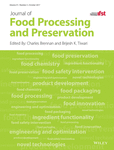Effect of whey protein concentrate, sodium caseinate, Cheddar cheese, and milk fat on sensory and functional properties of cheese dip
Funding information: National Dairy Research Institute; Indian Council of Agricultural Research, New Delhi
Abstract
Cheese dip was prepared using sodium caseinate, WPC-70, Cheddar cheese, carboxy-methyl cellulose, and glycerol mono stearate. The response surface methodology was employed for the optimization of level of protein blend, Cheddar cheese, and milk fat by studying the responses namely flavor, body & texture, color & appearance, firmness, stickiness, and apparent viscosity. An increase in protein blend and Cheddar cheese content was associated with decrease in flavor, body & texture, and color & appearance score and increase in firmness, stickiness, and apparent viscosity. The optimized conditions for the cheese dip were 8.82% protein blend, 6% Cheddar cheese, and 9.72% milk fat with desirability value of 0.929. Principal component analysis applied to data matrix has identified protein blend, Cheddar cheese/apparent viscosity, and milk fat as three principal components which explained 83.18% of variance in total. Color & appearance score was found dependent on Cheddar cheese content added to cheese dip.
Practical application
This study could successfully be utilized in preparing a new cheese product with high nutritional and functional properties owing to the presence of whey proteins. The product formulation and technology can be scaled up for commercial manufacturing. Introduction of such a healthy product as food adjunct in the market will be inline with the growing consumer demand of new and healthy convenience products.




